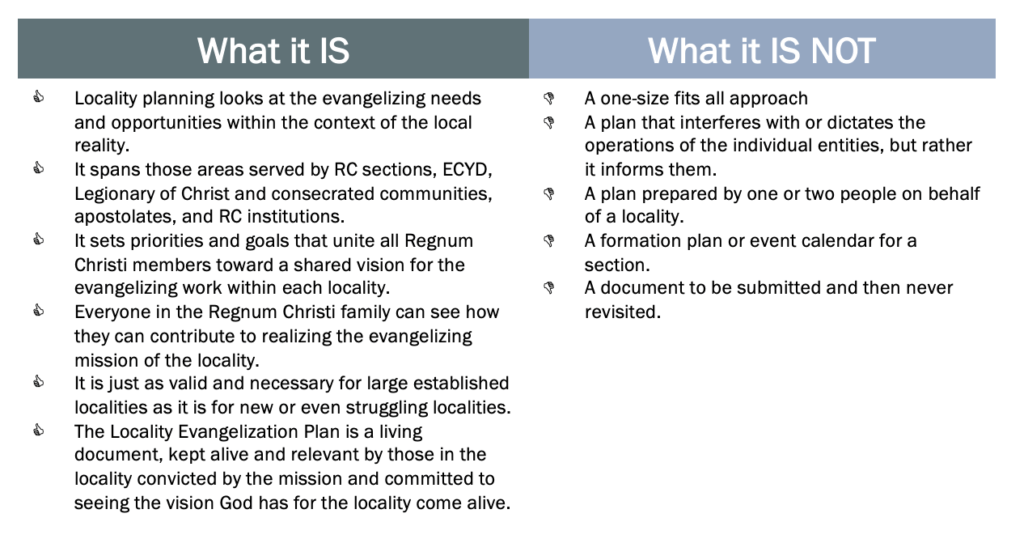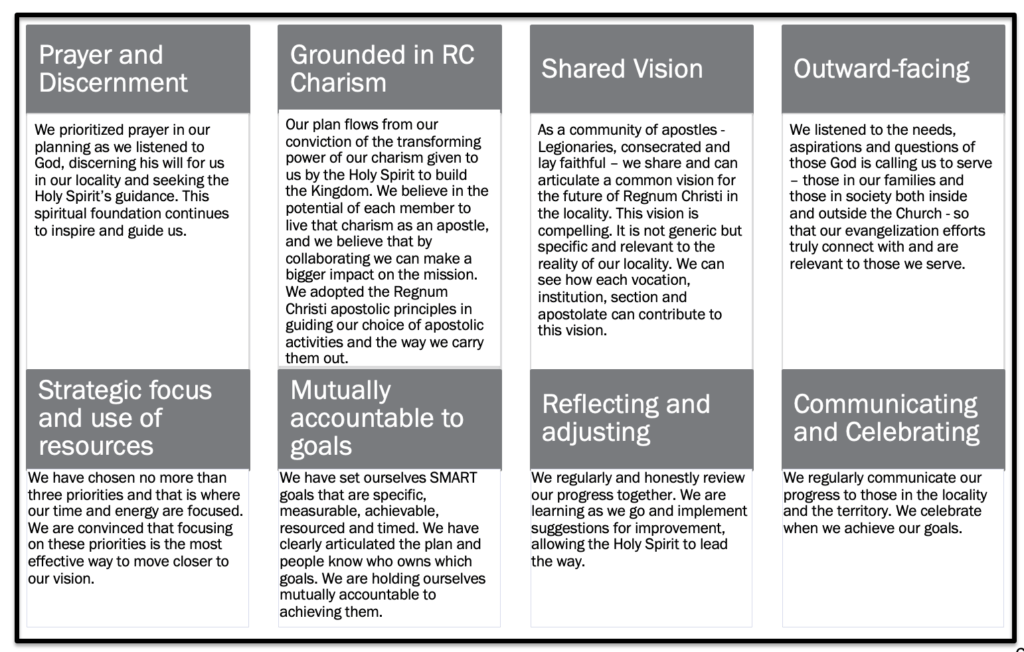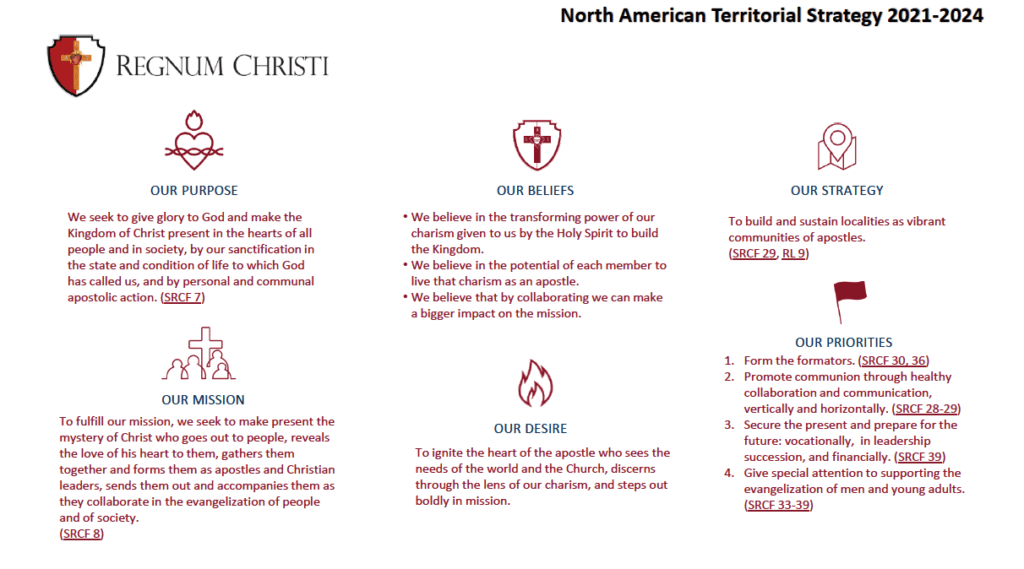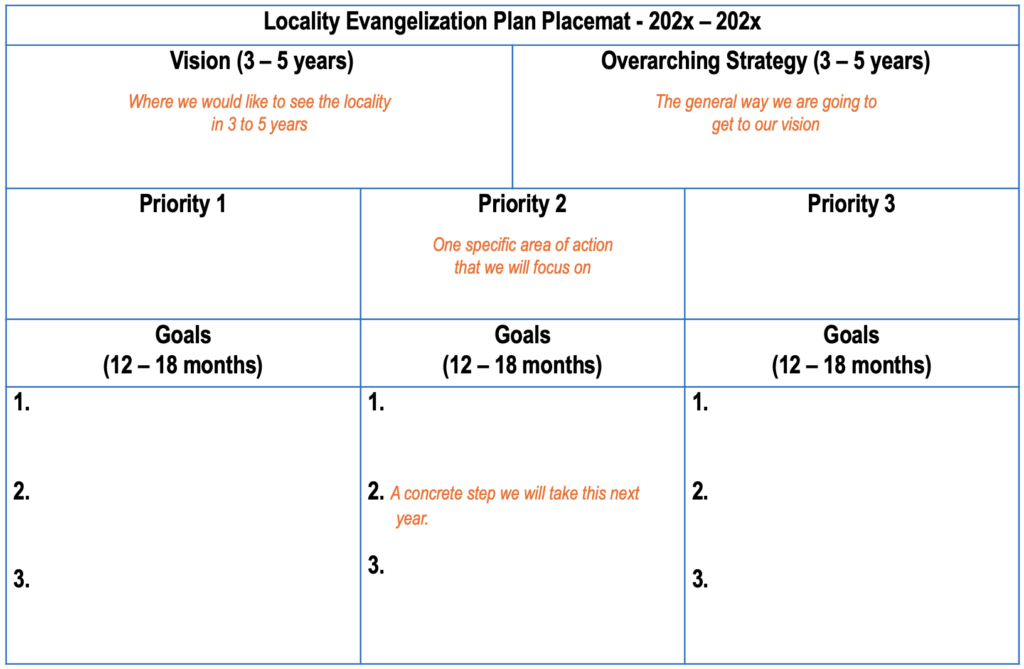LOCALITY
EVANGELIZATION
PLANNING

Downloads
- Locality Evangelization Guidebook (Powerpoint)
- Locality Evangelization Guidebook (PDF)
- Locality Evangelization Planning Roles
- Locality Evangelization Planning Tasks
- Locality Evangelization Project Management Tool
- Environmental Scanning Guide
- Indicators of a Vibrant Locality
- Locality Evangelization Plan Placement
- Section Plans - Areas to Consider
- How to Develop SMART Goals
- Locality Plan Implementation Monitoring
God’s burning desire is to live in communion with us and everyone around us for eternity. Yet, it seems in the 21st century that society has lost sight of this glorious destination for which we were made. We live in a secular society where the Christian faith is no longer deemed relevant. To the majority, the Church is no longer a credible witness to the truth, nor a relevant source to turn to with answers for the deep questions which burn in our souls. Our evangelizing mission appears daunting, yet it is to this very time and for this very mission that the charism of Regnum Christi is made present.
We, as baptized Catholics, are called to evangelize. We are called to build the bridges that draw people of today’s society to an experience of God’s love that penetrates their hearts and brings meaning and hope to their lives. As Regnum Christi members, we are invited to do this through our charism, making present that mystery of Christ the Apostle who goes out to people, reveals the love of his heart to them, gathers them together and forms them as apostles and Christian leaders, sends them out and accompanies them as they collaborate in the evangelization of people and of society (SRCF 8). We are called to collaborate with the Church in this work, being and forming Christian apostles to build Christ’s Kingdom here on earth. A unified and cohesive plan, discerned through the lens of our charism, helps us to do just that.
This noble call is why all localities are asked to have a Locality Evangelization Plan and to review that plan with the Territorial Directive College. Through planning, we commit ourselves to the responsible task of discerning how God is calling Regnum Christi to be made present in the reality of a particular locality. No two localities will share the same strategy, priorities or goals. In submitting our plans to the Territorial Directive College, we allow for meaningful collaboration across the territory and foster mutual accountability in our common mission.
We encourage everyone reading this guide to take heart in the transforming power of our charism. Imagine, as did the Territorial Directive College member quoted above, what it could look like when the Regnum Christi charism is fully alive in the locality. What will it look like when it is fully alive across this territory when all Regnum Christi members are united in the evangelizing mission God has called us to? In faith, we place ourselves at the service of the Church and all people and ask the Holy Spirit to ignite in our hearts a burning desire to give glory to God and make the Kingdom of Christ present in the hearts of all people and in society (SRCF 7).

1. What is a locality evangelization plan?
A Locality Evangelization Plan, as the name suggests, is a plan for how the Regnum Christi family present in a locality will collaborate in apostolic action to make the Kingdom of Christ present in the hearts of all people and in society (SRCF 7).
The locality planning process has four-phases. These phases guide Regnum Christi members to discern and answer the question, “How is the Holy Spirit calling Regnum Christi to cooperate with God’s plan to build the Kingdom within this reality, in this locality?” This process helps us to not only discern God’s will to serve the needs of our local church with our charism, but ensures the gifts, talents, and resources of our RC family are best used for his glory. The four phases of the process outlined in the figure below are explained in more detail in subsequent sections.

Locality Evangelization Planning is applicable for localities of all sizes, from those with a single small section to those with flourishing sections, institutions, apostolates and communities. While the scope of the planning effort will obviously vary, the value of discerning well how God is calling Regnum Christi members to serve the mission within this specific context remains consistent.
While there are countless planning methodologies available for locality leaders to use, this process has been adapted to address the specific needs of localities, using Regnum Christi language and examples where appropriate. This process can equally be applied at the level of the locality and at the level of a section or institution.
Many of us have experience with locality planning in some form or another. For the purposes of this guide, it helpful to clarify what we understand a Locality Evangelization Plan is and is not.

2. Eight marks of a good locality evangelization plan

3. Phase 1 - Prepare for Planning
There are four steps to take before any actual planning activity begins. At the end of this phase, you will have a clear idea of what you will need to do to develop the plan and have mapped out a broad planning calendar. You will have determined how big an effort planning will be and who you need to involve in the process. You will have invited someone to serve as the planning coordinator, and have ensured those people participating in developing the plan have the dates set aside in their calendars.
1.1 Name a Planning Coordinator
A planning coordinator will help you to design and then give good follow-up to the process of developing and monitoring the execution of the plan. Good candidates for this role will be people with strong organizational and planning skills. For smaller localities, the RC Director could potentially serve as the planning coordinator. The time commitment to serve in this role will depend on the planning approach you choose to take.
1.2 Define the Planning Approach
The planning approach you choose for your locality will depend entirely on your locality’s particular reality and needs. The output from this step will be clarity on HOW the planning will be conducted. In defining the planning approach, you will:
- clarify the scope of the plan (e.g., three-year strategic plan, one-year update of an existing strategy that is working well, etc.);
- agree on the level of involvement needed (e.g., just the leadership team, whole locality, etc.) to achieve buy-in and engagement;
- For example, invite leadership only when you are seeking to build cohesion among the leadership team; invite the leadership team and key influences when you are updating an existing plan; convoke a full summit when you need to rally the hearts of people in the locality.
- agree on the extent of up-front data gathering needed to adequately support the plan;
- agree on the style of planning session (1/2-day workshop, 2 day offsite, etc.) depending on which is best suited for your needs.
1.3 Establish Planning Core Team and Confirm Invitees
With the planning approach defined, you can determine who you need to involve to help make it happen. The output from this step will bring clarity and commitment on WHO will be involved at what stage of the planning process. There will be people who can serve on the core team, assisting the Planning Coordinator in handling the logistics, data gathering, and planning session preparation. There will be people invited to participate in the planning session itself. Often, in a largely ‘volunteer’ organization such as Regnum Christi, people’s availability is very limited which forces the planning team to be realistic in their expectations as to who can participate and at what level. Finally, it is helpful to consider inviting a Planning Session Facilitator to professionally facilitate the actual planning session.
1.4 Set Your Timeline and Lock in Dates on Calendars
With the planning approach and participants defined, you can finalize the timeline for developing the plan. The output from this step is a calendar with dates set and invitations sent that establish WHEN the planning process will progress. Depending on the situation of the locality, this timeline could range from less than one month to more than six months. With dates set, it is time to invite and lock-in participation for the planning
Phase 1 Tools (available online)
- Locality Evangelization Planning Roles
- Locality Evangelization Planning Tasks
- Locality Planning Project Management Tool
4. Phase 2 - Discern our Apostolic Mission
There are three steps in this phase of apostolic discernment. At the end of this phase, you will have a strawman, or first-take, of the locality’s vision, strategies and priorities. This phase begins with conducting a scan of the locality, collecting and then analyzing the information needed to give participants a grounded understanding of the current reality. Next is the planning session itself, in which participants reflect upon the charism of Regnum Christi and are guided toward developing (or reaffirming) a common vision for the evangelizing work in the locality and discerning together the priorities and overarching strategy that would best move the locality closer to this vision.
2.1 Conduct the Scan
The scan of the locality gives you objective information upon which to base the plan going forward. The scan allows you to examine, with input from those both inside and outside local circles, various foundational topics for planning including:
- The main issues that society is facing in your locality, particularly those that our charism is suited to address
- The priorities of the local diocese and how Regnum Christi is set up to serve those needs
- The sustainability of the local mission (vocationally, financially, leadership) to meet these opportunities over time.
Often, the work conducted during this step of planning will reveal the priorities for the locality.
Conduct external scan (context and opportunities)
We look outside Regnum Christi to identify the real needs of the people we are called to serve and to understand better the opportunities for supporting them and the local Church. What do the signs of the times tell us? What are the needs that our Regnum Christi charism is uniquely positioned to address? A good external scan helps create conviction as to what is important for us and why. Depending on the envisioned scope of the scan, this step could include interviews with diocesan personnel, non-members and other church groups, review of local cultural data, etc.
Conduct Internal scan (expertise and resources)
We look inside Regnum Christi to conduct an honest assessment of our internal health. What is Regnum Christi currently contributing to the local Church and society? What are we doing well and not so well? Where are we investing our resources now? A good internal scan helps us to be realistic about our possibilities. Depending on the envisioned scope of the scan, this step could include member surveys, focus groups, assessments of current operations of each RC entity in the locality, etc.
Analyze the data (conclusions and insights)
This final and important step is to assemble the data in such a fashion that planning participants can assimilate it, connect the dots, and draw conclusions – concrete insights as to what the data is telling us. What strategic advantages and challenges are facing Regnum Christi, and what does it look like God may be calling Regnum Christi to be and do in this locality? A good review of the data done in light of the charism will often reveal the path forward.
2.2 Revisit Purpose and Mission
This step of the process aims to ensure all participants are firmly centered on the supernatural foundations of the planning effort. It can happen that we get absorbed in the planning process and lose the perspective that Regnum Christi is a work of God, with a specific charism to offer the world. Through prayer and reflection, we allow the Holy Spirit to lead the way and endeavor to see the evangelization opportunities and planning process from the perspective of our charism.
The purpose, mission and apostolic principles of Regnum Christi as articulated in the Regnum Christi Statutes form the foundation of our evangelizing plans. It is helpful to review these together and in light of the reality in the locality. You can use various dynamics and group activities to help participants both experience the joy of communion that comes from being a part of this spiritual family and apostolic body, and to don the lens of the charism for the work ahead. This step can be done within the scope of the Planning Workshop or as advanced preparation.
2.3 Develop the Strawman
This step of the process is where the planning participants work together to agree upon a vision, overarching strategy and priorities for the locality. The outcome of this step will be a draft on a one-page ‘placemat’ that succinctly articulates the key messages of the locality’s plan and will ultimately serve as an excellent tool for communicating the locality’s plan to others.
This is typically the step that people associate most with planning – a planning workshop. While it is but one step in a more comprehensive process, it is the step that most serves to unite participants around a common vision and chosen direction. Often, localities will invite a professional to facilitate this session as the dynamics needed to achieve the objectives with the given audience can be challenging.
Vision
If Regnum Christi members are to step out boldly in mission, a shared and compelling vision of how Regnum Christi is called to serve this particular locality is essential. A good vision paints the picture of where we are going. It must be grounded in the reality of our current situation and respond to that interior urge to mission within the heart of each Regnum Christi member. A good facilitator can help the participants come to consensus on the vision.
If the vision paints the picture of where we are going, the overarching strategy and priorities are the chosen cascading pathways to reach the vision.
Overarching Strategy
An overarching strategy answers the question: How are we going to get there? It is a simple, clear statement that articulates the general path the locality decides to follow during the next few years to accomplish its mission. Generally, the overarching strategy becomes clear during the planning session.
Priorities
Priorities are levers that, if pulled, surge the locality forward toward reaching its vision. Good priorities are aligned with the strategy and will resonate deeply in the hearts of those participating, convicting them of the value of investing and even redirecting resources accordingly.
When defining a priority for the evangelizing mission (for example, Evangelizing Young Men) we work to describe it in an inspiring manner that helps members visualize it and see where they might fit it and contribute. We describe both the reason for choosing this priority (strategic intent) and share a micro-vision of what we expect it will look like if we are successful (and perhaps the impact if we are not successful!).
Draft the Placement
The vision, overarching strategy and the priorities are summarized onto a one-page ‘placemat’. This placemat presents the ‘strawman’ of the locality’s evangelization plan, meaning it is the first-attempt to articulate what the participants have discerned together. The work in the next phase will make use of this strawman as the starting point, and through deeper reflection, adjust, fine-tune and then confirm the plan.
Phase 2 Tools (available online)
- Environmental Scanning
- Indicators of a Vibrant Locality
- Locality Evangelization Plan Placemat – Template
5. Phase 3 - Develop the Plan
There are four steps in this phase to develop the actual plan. At the end of this phase, you will have clarity and agreement on the concrete initiatives, actions and resources needed over the next 12 to 18 months to move the locality toward its vision.
3.1 Validate the strawman
In this step, we take time to validate the strawman – taking both a horizontal and vertical look at it. Vertically, each Regnum Christi entity within the locality takes time to reflect upon the vision, overarching strategy and priorities in light of their concrete reality. How does this ‘strawman’ resonate with our particular situation and plans? How can we contribute to this priority? What changes would it imply to our plans? Vertically, across entities, we can ask how this strawman aligns with Regnum Christi’s call and capacity to serve the needs of the society and the church as identified in the scan. How will this strawman move us forward in our mission? Feedback is collected and examined as a whole, allowing the planning team to adjust and fine-tune the strawman as needed. Depending on the planning approach adopted by the locality, this step can be done within the planning workshop itself or in the weeks that follow. The outcome of this step is broad agreement on a locality strategy: the vision, overarching strategy and priorities.
3.2 Establish 12-18 month goals
In this step, the planning participants agree on the goals for each priority. In all likelihood, the goals and any associated initiatives will have surfaced during the previous step, and the work in this step is to clarify and prioritize.
Generally, we aim to set three (max five) concrete 12-18 month goals for each priority, marking out the chosen pathway forward toward our vision. In defining these goals, we try where possible to be clear and concrete, setting SMART goals that are specific, measurable, achievable, resourced and timed.
This effort to develop SMART goals, while challenging, force the necessary conversation needed to clarify and align our thinking. Honing in on SMART goals helps to ensure we have sufficient direction and resources to follow-through, making them more motivating and captivating than good but vague ideas. While some goals are not easily written as SMART goals, they still need to enable you to clearly mark out the next steps forward.
The outcome of this step will be agreement on the goals or initiatives for each priority and clarity on who is the person responsible for leading the initiative (goal owner). Again, depending on the planning approach adopted by the locality, this step can be done within the planning workshop itself or in the weeks that follow.
3.3 Develop action plans
In this step, the goal owner for each goal or initiative works with his team to flesh out the concrete 12+ month action plan to reach the goal, coordinating with other locality leaders as needed. This action plan can be more or less detailed depending on the circumstance, but at a minimum, it would typically include key milestones (what will happen by when), personnel requirements (who is involved in the work) and financial requirements (budget). This step generally occurs outside the planning workshop as it requires an investment of time and teamwork.
3.4 Consolidate and finalize plan
In this step, all the components of the plan are brought together and validated against the reality of the locality. This ‘reality check’ may involve several back-and-forth efforts as adjustments to the individual action plans are made.
A natural and important consequence of locality planning is the need to develop associated financial and resource projections to support the plan. The financial plan helps the locality allocate money and coordinate its fundraising efforts, and the resource projections help with succession planning and serve as strong rationale for assignment petitions for Legionaries and consecrated personnel.
Finally, we must also look ahead to those aspects essential for executing the plan: a communications plan and an accountability plan.
The outcome of this step will be a single document, the locality evangelization plan. Depending on the scope of the plan, it could include a summary of the planning process, presentation of the vision, overarching strategy, priorities, goals, a high-level milestone calendar, resource requirements, budget, communication plan and accountability plan.
For practical purposes, the locality plan is also summarized on the one-page ‘placemat’ (see section 9). This simple and concise format is a tool that helps every Regnum Christi member to become familiar with and be able to articulate the common evangelization plan of the locality. It serves as a consistent reference point for ongoing communications and locality plan implementation oversight.
Phase 3 Tools (available online)
- Section Plans – Areas to Consider
- Develop SMART goals
6. Phase 4 - Live the Plan
The final phase of locality evangelization planning is living the plan. The key to success of our whole planning effort rests largely in our commitment to implementation. This phase involves aligning ourselves to the plan, regularly monitoring progress and engaging our people in its implementation. By God’s grace, the outcome of this phase will be the experience of the Regnum Christi charism alive in the locality. We will see Regnum Christi members united in mission, convicted by the experience of seeing each other contributing their part, and emboldened as the shared vision becomes reality.
4.1 Align resources
Setting priorities and concrete goals will likely imply the need to adjust how things are currently done in a locality. As the locality tackles its priorities, other aspects of the mission may need to be dropped or deferred. Aligning resources may imply setting up committees to tackle certain objectives, shifting financial support to certain projects, or reorganizing who is responsible for what. The locality needs to be both realistic and committed to making the changes that need to be made. A failure to do so can be demoralizing if people are simply asked to take on more responsibilities.
4.2 Monitor progress
The RC director, with support from the planning coordinator, takes a lead role in facilitating the regular monitoring of the plan – the accountability plan. It is helpful to have a defined ‘meeting architecture’ which clearly sets out who meets with who, when, to review what aspects of the plan. At a minimum, locality leaders and goal owners would come together quarterly to review results and progress toward goals both as a means to exercise mutual accountability and to identify opportunities for collaboration.
4.3 Reflect and adjust
Every twelve months, the locality takes time to consciously pause, reflect, update goals and action plans, and set out again. Nevertheless, as we execute on the plan, circumstances will change, and we will learn as we go. Adjustments to the plan will be needed along the way. The planning coordinator helps facilitate this process, working with those impacted by the changes, and ensuring commitment to the plan remains strong.
4.4 Celebrate
Locality leaders openly and proactively share their commitment to the success of the locality plan, its vision, priority and goals. They look for opportunities to communicate the supernatural origin and vision behind the locality plan as a means to engage members in mission, and to regularly communicate the progress and results of the locality’s work, acknowledging and celebrating achievements along the way.
Phase 4 Tools (available online)
- Locality Plan Implementation Monitoring
7. Support for locality evangelization planning
Locality evangelization planning benefits Regnum Christi in multiple ways. Just bringing the various entities in a locality together is a fresh experience of our charism. Gathered with the intent of discovering how God is calling us to cooperate with him as Regnum Christi in the work of evangelization, we experience his love, form ourselves as his apostles, and then set out to collaborate in the evangelization of people and of society. When a locality lives out its commitment to the execution of the plan, we see the charism come fully alive.
Nevertheless, we acknowledge that planning can be challenging. The time commitment can seem overwhelming and to some, the process can seem of little value. Deciding on the planning process itself can be complex given the many planning methodologies available. Knowing what steps to take and who can take them is not always obvious. As such, the Mission Support Office is committed to providing support to localities and offers the following:
Tools and Templates
A library of tools and templates will be made available on the RC Mission Support website. These resources will be updated as new good practices are made available.
Training
Once a year, the Mission Support Office provides training for RC directors and their locality planning coordinators. Contact the RCD Support team for more information. Recordings of previous training sessions will be made available on the RC Mission Support website.
Locality Planning Coordinators Network
All locality planning coordinators are invited to join the network of their colleagues to share best practices and periodically meet for ongoing professional development.
Coaching & Facilitation
One-on-one locality planning coaching is available. Depending on the degree of support required, fees may be applicable.
Accountability
Each locality is asked to have a locality plan approved by the Territorial Directive College. The RCD Support department works with the RC director to hold them accountable to this while making support resources available as needed.
9. Territory Strategy Placemat




